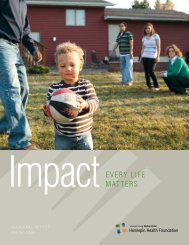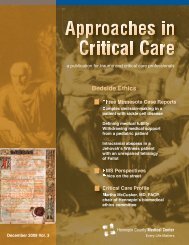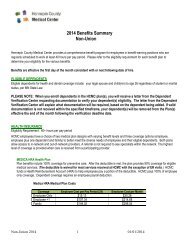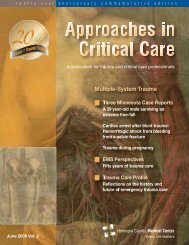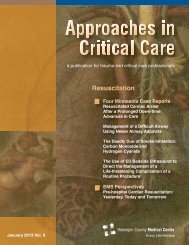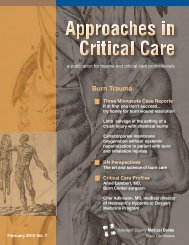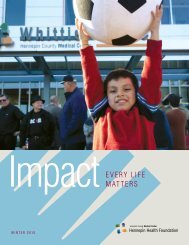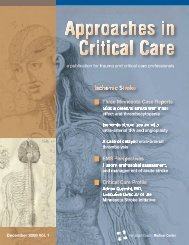Pediatric Trauma - Hennepin County Medical Center
Pediatric Trauma - Hennepin County Medical Center
Pediatric Trauma - Hennepin County Medical Center
Create successful ePaper yourself
Turn your PDF publications into a flip-book with our unique Google optimized e-Paper software.
RN Perspectives<br />
FASTR-HUG can be a<br />
simple way to remember<br />
the esentials of ICU care<br />
that arenʼt always in the<br />
forefront of our priorities<br />
for critically ill patients with<br />
numerous medical needs.<br />
RN Perspectives: Give your patients a “FASTR HUG”<br />
by Shayna Hamiel, RN, BSN, CPN, CCRN<br />
<strong>Hennepin</strong> <strong>County</strong> <strong>Medical</strong> <strong>Center</strong><br />
You may have heard about the acronym<br />
“FAST HUG”, introduced by Jean-Louis<br />
Vincent in relation to the essential aspects<br />
of care for all ICU patients. When patients<br />
are being rushed into the unit in critical<br />
condition, their medical needs are great,<br />
with our minds shifting gear to prioritization<br />
of stabilization and our classic ABCs.<br />
However, there are several aspects of<br />
intensive patient care that need to be<br />
addressed in order to optimize stability and<br />
improve patient outcomes. The FAST HUG<br />
acronym helps guide us through these<br />
important aspects of care that can have<br />
adjunctive effects leading to overall wellbeing.<br />
These aspects need to be addressed<br />
on admission as well as on a daily basis as<br />
we strive towards comprehensive care.<br />
With skin being the largest organ in the<br />
human body, it is becoming more of a<br />
focus among health care workers in all<br />
areas, but has yet to be fully given the<br />
importance that it deserves. Wounds,<br />
pressure ulcers, and skin breakdown of all<br />
types, both acute and chronic, can lengthen<br />
hospital stay and increase morbidity and<br />
mortality. Hospital related skin issues need<br />
to be more of a priority for hospital workers<br />
at all levels, with an emphasis on early<br />
detection and intervention, but more<br />
importantly, prevention. In our practice in<br />
the PICU, we are working on a way to<br />
incorporate skin and prevention into our<br />
daily care of ICU patients, and have added<br />
the “R” to Vincentʼs acronym in order to put<br />
skin into the forefront of our thinking with<br />
each admission to our unit.<br />
F-Feeding<br />
Consider nutrition right from the start.<br />
Malnutrition can complicate all body<br />
systems and worsen outcomes for critically<br />
ill patients. Good nutrition is especially<br />
essential for wound healing and is a part of<br />
the Braden and Braden Q risk assessment<br />
tools for skin breakdown. If you know your<br />
patient is not going to be able to eat<br />
normally for any extended period of time,<br />
don't delay feeding tube placement.<br />
Enteral nutrition is generally preferred over<br />
parenteral nutrition. Although the Braden<br />
scale does not give full points for tube<br />
feedings, many dieticians will argue that<br />
the right formula being fed into the<br />
stomach or jejunum can offer equal or<br />
better nutrition than what the patient might<br />
be getting on a regular diet.<br />
16 | Approaches in Critical Care | June 2011



